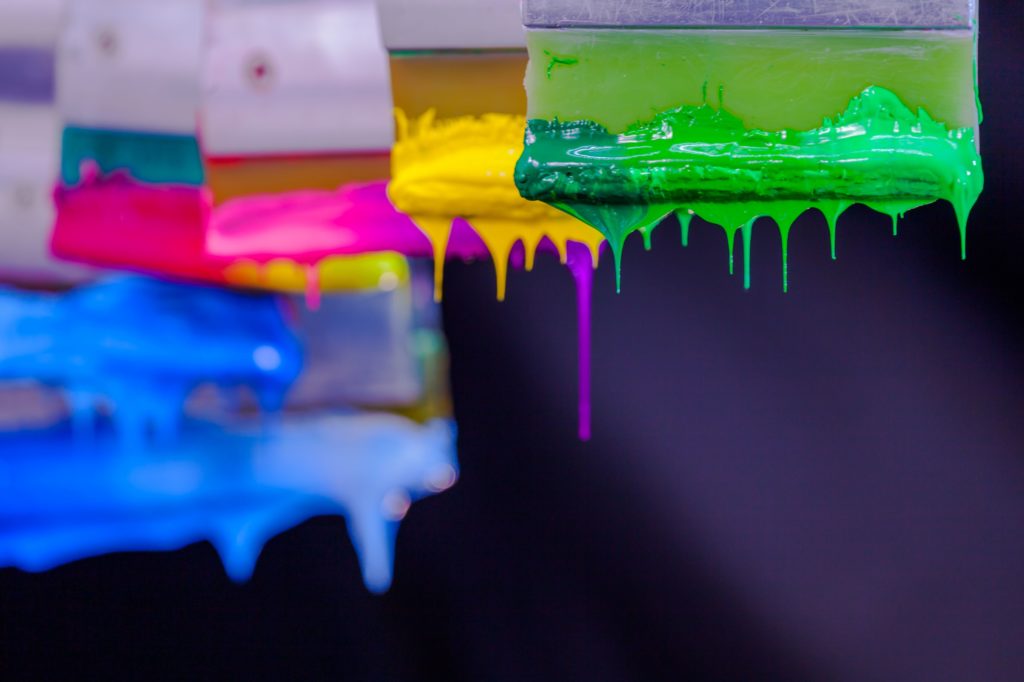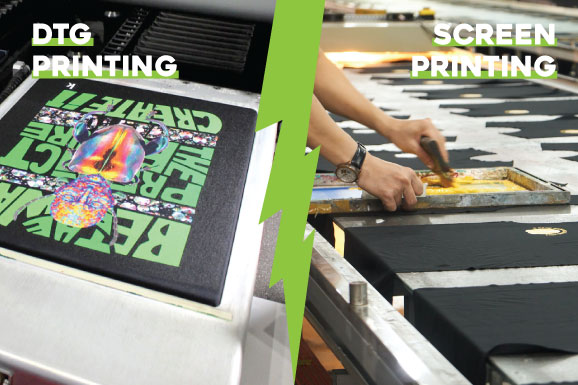
Which Type of Printing—Screen or DTG—should You Use?
Direct-to-garment (DTG) printing and screen printing are two common techniques for imprinting images on clothing. Your particular needs and preferences will determine which strategy is best for you because each has benefits and drawbacks.
Traditional printing techniques like screen printing include pushing ink onto the fabric through a stencil or screen. It works best when printing numerous copies of straightforward or monochromatic patterns. The ink used in screen printing typically lasts longer than that used in DTG printing, and it is quite durable. It takes longer than DTG printing to set up and clean up, and it is also more labor-intensive.
An advanced printer is used to print designs directly into the garment in DTG printing, a more recent technology. DTG printing is perfect for printing small quantities of intricate graphics or multicolored designs. It creates prints of the highest quality with vivid colors and gradients. The ink may eventually fade or crack with DTG printing, though, especially if the garment is washed regularly. DTG printing is less resilient than screen printing.
In conclusion, screen printing is preferable if you need to print a lot of straightforward designs or designs with few colors. DTG printing is the preferable choice if you need to print a small number of intricate graphics or designs with lots of colors. The decision between the two ultimately comes down to your own requirements and priorities.
Screen Printing: What Is It?
Ink is transferred onto a substrate (such as paper, fabric, or plastic) using the classic printing method known as screen printing through a fine mesh screen. A photo-reactive emulsion is applied to the screen first, and a design or image is then exposed to it using a light source. The emulsion gets harder and more impermeable where the light touches it, while remaining pliable and soft where it is not exposed.
Ink is then poured over the top of the screen after it has been set up on the support. The ink is forced through the porous portions of the screen and onto the substrate below by pulling it across the screen with a squeegee. With a different screen for each color, the procedure is repeated for all of the colors in the pattern.
Screen printing is frequently used to print on paper for posters, decals, and other printed items as well as fabrics like t-shirts, hoodies, and tote bags. It is a flexible and robust printing technique that can create prints of exceptional quality and longevity with vivid colors and precise details. Screen printing is more appropriate for larger print runs, but it is labor-intensive and takes a lot of setup and cleanup time.
How Does DTG Printing Work?
A customized inkjet printer can print full-color designs directly onto clothes using DTG (Direct-to-Garment) printing, a digital printing technology. T-shirts, sweatshirts, and other fabric goods are frequently printed with DTG printing.
DTG printing involves placing a garment on a flatbed printer, which then prints the pattern directly onto the fabric using a specialized inkjet printhead. A bright and long-lasting print that resists fading and cracking over time is produced by DTG printers using specialist inks that are designed to connect with the fabric fibers.
DTG printing is perfect for small to medium print runs and is frequently used for on-demand printing, custom designs, or prints that need a lot of detail or several colors. The technology is well-liked for printing on clothing products like t-shirts, hoodies, and sweatshirts because it can create graphics that are photo-realistic with subtle details and gradients.
The fact that DTG printing does not require the use of screens means that designs may be readily modified without incurring additional setup costs. This is one of the main advantages of DTG printing. For bigger print runs, the procedure could be slower and more expensive than standard screen printing. Moreover, not all types of materials may work well with DTG printing, and the print’s quality may change based on the type of fabric and the color of the garment being printed.
Screen Printing vs. DTG: Which Is Better?
Your particular requirements and priorities will determine whether you choose screen printing or DTG (Direct-to-Garment) printing.
Digital printing technology called DTG is perfect for producing small to medium print runs of full-color artwork with intricate details or numerous colors. With DTG printing, you may create personalized designs that are easily adjustable without paying additional setup fees. DTG printing can create photo-realistic graphics with subtle details and gradients and is perfect for printing on light-colored materials.
On the other hand, screen printing is a time-honored printing method that is perfect for printing several examples of straightforward or monochromatic designs. Vibrant colors and precise details can be printed with screen printing that is durable and long-lasting. However, screen printing can take longer than DTG printing to set up and clean up, and it can also be labor-intensive.
The decision between screen printing and DTG printing ultimately comes down to your individual requirements, financial constraints, and desired results. DTG printing is the preferable choice if you need to print a small to medium-sized print run of full-color designs with high levels of detail or numerous colors. Screen printing might be a better choice if you need to print a lot of simple or monochromatic graphics.
In conclusion, both screen printing and DTG (Direct-to-Garment) printing are common techniques for imprinting images on clothing, but which one you choose will depend on your individual requirements and goals.
Screen printing is better suited for huge volumes of straightforward designs or designs with few colors, while DTG printing is appropriate for small to medium print runs of full-color drawings with high levels of detail or many colors. While screen printing delivers durability and long-lasting prints with brilliant colors and fine details, DTG printing offers the option to print on-demand or for unique designs that can be readily modified without additional setup expenditures. The decision between screen printing and DTG printing ultimately comes down to your individual requirements, financial constraints, and desired results.
